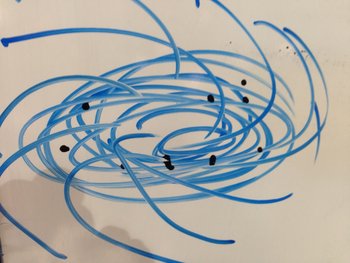Pulsar Voices

Feel the pulse of the universe
We're taking signal data from astronomical "pulsar" sources and creating a way to listen to their signals audibly.
Pulsar data is available from ATNF at CSIRO.au. Our team at #SciHackMelb has been working on a #datavis to give researchers and others a novel way to explore the Pulsar corpus, especially through the sound of the frequencies at which the Pulsars emit pulses.
The Team
* Tomy(sarathtomy) - web dev, php, JavaScript, SQL, phpmyadmin, CDs, html, visualising pulsar
* Gary(gazzar) - python tech, visualising sound of a single pulsar
* Chris(csirochris) - data manager, accessing CSIRO pulsar data and manipulating it to a useful format
* Anderson(castlebravo) - SQL
* Michael(schrocat) - transforming pulsar coordinates, azimuthal to cartesian
* Richard (areff2000) - data analyst, datavis advisor, data management
* AAD - R analysis of pulsar distance, frequency distribution
* Advisors: CSIRO Jess Robertson (focus on simple, doable outcome), AAD
The Data
* RA - east/west coordinates (0 - 24 hrs, roughly equates to longitude)
* Dec - north/south coordinates (-90, +90 roughly equates to latitude i.e. 90 is above north pole, and -90 south pole)
* P0 - the time in seconds that a pulsar repeats its signal
* f - 1/P0 which ranges from 700 cycles per sec, to some which pulses which occur every few seconds
* kps - distance from Earth in kilo-parsecs. 1 kps = 3,000 light years. The furthest data is 30 kps. The galactic centre is about 25,000 light years away i.e. about 8kps.
Method
We plotted RA, Dec on a rectangular screen roughly to see pulsar location.
One of us, Gary, worked on one pulsar data, turning the frequency into sound. A graph shows the variation in pulse between pulses. Another of the team, piotted a histogram of the range of pulsar frequencies, which shows a nice bi-modal distribution. Why is it bi-modal, we will have to ask a pulsar scientist.
What is still left to do?
* load data, description, images hamlet to figshare :: DOI
* add overview images as option eg frequency bi-modal histogram
* colour code pulsars by distance; DONE
* add pulsar detail sound to Top three Observants
* add tones to pulsars to indicate f; DONE
* add tooltips to show location, distance, frequency, name; DONE
* add title and description
* project data onto a planetarium dome with interaction to play pulsar frequencies
* zoom into parts of sky to get separation between close data points
More at: http://areff2000.github.io/2016/03/05/pulsar-voices.html
BESbswyBESbswyBESbswyBESbswyBESbswyBESbswyBESbswyBESbswyBESbswyBESbswyBESbswyBESbswyBESbswyBESbswyBESbswyBESbswyBESbswyBESbswyBESbswyBESbswyBESbswyBESbswyBESbswyBESbswyBESbswyBESbswyBESbswyBESbswyBESbswyBESbswyBESbswyBESbswy
